|
|
|
|
.
Stock Yards branch
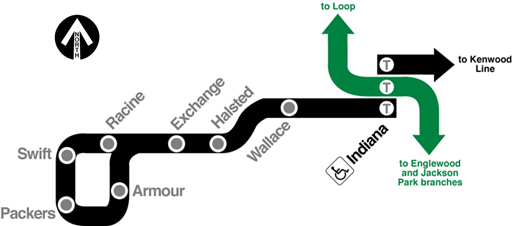 |
|||||||||||||||
|
.
Click on a station name to see that station's profile (where available) |
|
|
|
|
.
Stock Yards branch
 |
|||||||||||||||
|
.
Click on a station name to see that station's profile (where available) |
Service Notes:
History:
Many "L" lines and extensions were built to serve housing developments and business districts. But unique among the city's rapid transit lines was one that was built to serve just one industry (albeit one made up of several companies): the famous Chicago Stock Yards.
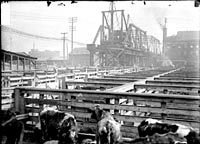 Construction of the Stock Yards main line is progressing in this 1907 view looking over the cattle pens that were the line's raison d'etre. For a larger view, click here [off-site link]. (Image #DN-0004837, Chicago Daily News negatives collection, Chicago Historical Society Collection) |
Although this was largely intended as a freight line for interchange traffic between the yards and various connecting railroads, as early as 1882 passenger service was also being run there. Stations at Lake Park, Cottage Grove, Langely, Vincennes, Grand Boulevard (later South Park and now King Drive), Indiana, and Michigan were served by various trains, some acting as Stock Yards-Kenwood locals, some offering service downtown to LaSalle Street Station, some Illinois Central runs going as far south as Riverdale, and by 1898 some stock yards shuttles to Indiana, so that passengers could transfer to the South Side Elevated there. The same year, the various railroads that owned and operated the trackage merged to form the Chicago Junction Railway.
Stock Yards-Kenwood passenger service continued until 1904, when outside pressures allowed the "L" to enter into the story. On March 16, 1903, the Chicago City Council passed an ordinance requiring the elevation and grade separation of the 40th Street line. This was part of a larger effort by the city to eliminate grade crossings to increase safety and improve traffic flow all over the city. To protect themselves against possible financial hardship (the cost of the elevation was seen as very high, if not potentially ruinous), a subsidiary company, the Chicago Junction Railroad, was incorporated in 1902. Passenger service from the Stock Yards to LaSalle Street Station downtown continued until 1908.
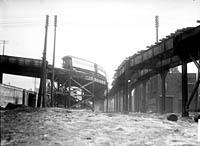 This view looks east at 40th and State streets where the South Side main line (left) turns back north on its way to the Loop while the Stock Yard branch (right) continues west on its way to Packingtown. This view dates from 1908, the year the branch entered service. For a larger view, click here [off-site link]. (Image #DN-0005793, Chicago Daily News negatives collection, Chicago Historical Society Collection) |
The Stock Yards branch extended westward from the Indiana station and headed westward toward the Stock Yards. Originally, it was planned to have the branch leave the main line southbound at 40th and Wabash, turning west toward the yards as the main line turned east toward Indiana station. This would have allowed direct service from downtown, but would have completely avoided Indiana station. The stub alignment into Indiana was preferable because the branch was intended to transport workers from their South Side homes to the plants, and the laborers were more likely to live east or south of the Stock Yards than north toward or in downtown. As the branch headed west, it made several small zig-zags inching south, eventually amounting to a little more than a block, putting it along an alignment at approximately 4100 South when it reached the yards. At the west end in the Stockyards, the branch ended in a single track loop around the "Packingtown" section of the yard, where most of the companies had their meat packing plants. Although there were very few actual streets in the Stock Yards (and what streets existed were covered with railroad tracks, loading docks, and roaming cattle),the loop generally followed Exchange Avenue, Packers Avenue, 44th Street, and Racine Avenue. Unlike the branch's Kenwood counterpart, the Stock Yards branch was constructed as a conventional steel elevated structure. This allowed the right-of-way to snake around the Stock Yards easier and to be more easily carried above the Chicago Junction's tracks.
On September 30, 1903, the Chicago Junction Railroad and the South Side Elevated signed a 50-year lease, with options for two 50-year renewals and an option to buy. One clause said that if the elevated failed to make lease payments to the Chicago Junction for a period of six months, it could seize the property and operate it on its own. This clause would become a major issue in later years, both for the Chicago Rapid Transit and for the CTA when the 50-year period (after operations began) was up in 1957.
Stock Yards Branch Opens
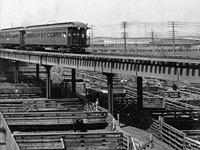 Demonstrating how much of the Stock Yards branch traveled over a maze of industry rather than actual streets, a two-car Stock Yards train led by South Side Elevated car 157 passes over livestock pens near Exchange station in 1911. The bow trolley's on top of the cars are for use in 61st Street Yard and the white sign on the side of second car indicates it's a smoking car. For a larger view, click here. (Photo from the CTA Collection) |
The branch had seven stations: three along to trunk line -- Wallace and Halsted outside the Stock Yards and Exchange Avenue inside the yards -- and four stations on the terminal loop: Morris (later called Racine), Swift, Packers, and Armour. The stations on the truck line had dual side platforms with peaked canopies similar to what is found on the old Englewood branch stations, with mezzanine station houses. The Packingtown loop stations were similar, except that they only had a single side platform serving the single loop track (with the Racine and Swift platforms on the outside of the loop and Packers' and Armour's platforms sited on the inner side of the track).
The branch actually had a small yard and one-track inspection shop at Union Avenue, near Wallace station, but records show that it was seldom, if ever used. Although an abandonment date is not known, a 1919 report compiled by the Illinois Public Utilities Commission stated that the yard tracks had already been torn up. The structure remained in place for an unspecified number of years after.
Base service consisted of Stock Yards-Indiana shuttles. A few Stock Yards-61st Street and Stock Yards-Kenwood through-trips were also run, and by 1919 a few trips between the Stock Yards and 18th Street, for workers living north of 40th Street, were operated. Stock Yards trains operated in a counterclockwise direction around the Packingtown loop.
Life in the Yards
The Stock Yards branch operated for several decades with little change. Meanwhile, the Stock Yards itself made Chicago the center of the American meat packing industry for decades. At one point, more meat was processed there than in any other place in the world. In fact, the size and scale of the Stock Yards along with technological advancements in railcar refrigeration made some of the meatpacking companies there some of America's first truly global companies, such as the namesake companies owned by men like Gustavus Swift and Philip Armour.
Approximately 50,000 people worked in the Stock Yards, providing ample ridership for the "L" branch. As the Illinois Labor History Society describes the area, the headquarters offices of the big packing companies, with hundreds of white collar jobs, were right in the midst of the slaughter and processing buildings. The plants themselves were an intricate network of hundreds of interconnected buildings in which the hogs, cattle, and sheep were slaughtered and "disassembled" into cuts of meat. Hundreds of byproducts, from animal feeds to tennis racquet strings, and pharmaceuticals were made by the many thousands of men and women who worked in the "Yards," as people called the area. Working conditions were hard, and often unpleasant. With poor safety conditions by today's standards, the possibility of injury from the machinery was everywhere. It was a hard living.
 A fire in the Stock Yards in May 1934 consumed everything in its path, including a two-car train trapped west of Halsted, whose platform this view looks west from. For a larger view, click here. (Photo from the Krambles-Peterson Archive) |
About 25 years later the "L" wouldn't be so lucky. On May 19, 1934, another major fire was ignited in the Stock Yards, started by a careless smoker flicking their cigarette butt. Starting in the hay barn of the Yards, the flames fed quickly off the dried grass and leapt from pen to pen, burning the tinder-like infrastructure, scorching livestock and threatening the huge packing plants. The flames jumped the Stock Yards fence and engulfed the buildings along Halsted Street, torching three blocks of the street before the conflagration was brought under control. Consumed in the blaze were the Livestock Exchange and Dexter Pavilion, where livestock were shown; the Stockyards Inn, where packing tycoons had dined and dealt; the Department of Agriculture Building; two banks; and a radio station. The fire also burned the Halsted "L" station and consumed a 2-car train trapped west of the station, resulting in the severing of the Stock Yards branch in two. Service west of Halsted station was suspended for months while the station and elevated structure were restored. Restoration of service was delayed by a dispute over who should pay to rebuild the structure: the Chicago Rapid Transit Company (the "L" operator), the Chicago Junction Railway (the property owner), or the meat packing companies (whose flammable and poorly protected livestock pens fed the fire). Stock Yards "L" operations didn't resume west of Halsted and around the Packingtown loop until January 16, 1935. All tallied, the fire burned up $8,000,000 worth of property and many cattle, sheep and hogs.
Decline
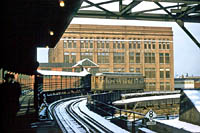 As the branch nears the end of its life, ex-Met car 2905 is more than sufficient to handle the lights traffic as the car turns south at Swift (station in the foreground, company in the background) on December 29, 1956. The car is coming toward the camera, but note the sign in the lower right: Although the Packingtown loop was single tracked and unidirectional, this photo dates from a period in 1956-57 was trains were run bi-directionally as a result of a fire that damaged the structure. For a larger view, click here. (Photo from the IRM Collection, courtesy of Peter Vesic) |
On August 1, 1949, the CTA instituted its North-South service revision, reorganizing the city's north-south "L" lines and streamlining services. Unlike other routes, the Stock Yards branch, which was and always had been mostly a shuttle, saw little change. The few Monday-Friday Stock Yards-Jackson Park trips were discontinued. All Stock Yards service was now a shuttle to Indiana station.
By the early 1950's the Stock Yards were dying. The Yards saw its peak year in 1924 and then a gradual decline started caused by decentralization into regional markets and packing operations. New technology, which helped build the Chicago stockyards and packinghouses, ironically led to their demise. After World War II, the rapid growth of the federal highway system and the development of the refrigerated truck allowed packinghouses to move out of the expensive urban areas they had depended upon for railroad access. Competition in the meatpacking business led to the building of sophisticated, mechanized plants in less expensive rural areas. Additionally, meatpackers began conducting business directly with farmers, thus bypassing the need for the stockyard. Finally, urban growth, with its increase in land value, property taxes, and anti-pollution laws, also contributed to the stockyards' decline. By the '50s, Armour, Swift, and others were planning their departures. Beginning with Wilson and Company in 1955, the major meatpacking companies began closing down.
Since the Stock Yards branch served strictly to connect the South Side "L" main line with the Yards, once the Yards started downhill there was no way to justify keeping a line whose annual rent was greater than the revenue collected. CTA put together a report showing fares paid by station by year that showed just how dramatic these drops really were.
On May 3, 1952, CTA closed Wallace station due to extremely low ridership. By the mid-1950s, the Kenwood and Stock Yards lines were the only services using wood cars in non-rush hours.
 At the end, the Stock Yards cars looked very tired and worn. Car 2906, seen heading west into Exchange station on September 28, 1957, probably hasn't been painted or even washed in years. The Stock Yards branch was only a week away from abandonment at this point, and 2906 -- indeed, all wood cars -- would be retired then too. For a larger view, click here. (Photo from the IRM Collection, courtesy of Peter Vesic) |
Given the branch's rapidly declining ridership and the obviously doomed fate the Yards itself, it is amazing that the CTA put the money and effort into restoring the loop. Nevertheless, repairs were complete several months later and on April 8, 1957 Packers station reopened and operation around the Stock Yards loop resumed, though reduced slightly to Monday-Saturday day and evening hours only.
The work put into repairing the Packingtown loop and restoring service was all for naught, as the branch's fate was sealed just a few months later. Citing declining revenues, insufficient ridership, and a poor outlook for improved patronage, the CTA discontinued all service on the Stock Yards branch on October 6, 1957, closing Halsted, Exchange, Racine, Swift, Packers, and Armour stations.
After Abandonment
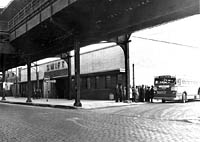 Stock Yards workers are boarding a #9 Ashland-Stock Yards bus on January 23, 1954 at the boarding area in the Swift plant parking lot at 42nd and Packers used for Stock Yards special buses. This same lot would be used for the #43 Stock Yards Limited buses four years later when they replaced "L" service. The Swift station is seen in the upper left. For a larger view, click here. (Photo from the CTA Collection) |
These buses that served the Stock Yards were modified at regular and frequent intervals during the following decade. On June 13, 1958, the routing of all #43 buses serving the yards was extended via Exchange to a new Packers terminal-Packers Avenue-Swift parking lot west terminal loop. With operations in the Stock Yards dwindling and ridership on the route modest, the Stock Yards Limited service was discontinued on March 26, 1962. To compensate, some Monday-Friday midday buses on the regular #43 route were extended to the corner of Packers and Exchange. In July 1967, the route was briefly cut back to terminate in an Exchange-Morgan-40th-Peioria loop, then re-extended to the Packer "U" terminal two months later. In 1970, the bus was cut back again to a similar Exchange-Racine-40th-Morgan loop.
The Stock Yards continued to hobble along for another 15 years or so, but changes in the meat packing industry had made it obsolete and it died a slow death in the postwar period. Finally, by the 1970s, the last companies left in the facility finally packed it in. At midnight on Friday, July 30, 1971 the Chicago Union Stock Yards officially closed. As a result, in July of the next year the CTA discontinued all service west of Halsted into the old yard, but put the service back in September.
The area, now called "New City" (although longtime Chicagoans still refer to some of the surrounding neighborhood as "Back of the Yards"), slowly began to redevelop. It has since become an industrial park, home to various small factories, although none are involved in the meatpacking industry. Virtually no structures remain from the old yards except for the giant limestone arch, erected in 1879, which marked the entrance to the Stock Yards, now at the Chicago Historical Society. On March 26, 1995, the west terminal of the #43 43rd bus was extended to a new, larger loop in the former yards via Exchange-Morgan-45th-Racine-40th-Morgan-Exchange.
The Stock Yards branch was all on steel structure mostly south of but in places over the Chicago Junction tracks. For a while, at some streets one could see the stubs of the elevated structure in the sidewalk where it was cut off, but sidewalk rebuilding has removed most if not all of these in recent years. Within the site of the former Yards itself, there is no evidence at all of the old elevated line. Until about 10 years ago, there was a single upright steel bent standing near the site of the former Packers station at 45th and Racine, supporting a light, but it is now gone too. The only telltale evidence of the branch is the arrangement of the once-adjacent concrete embankment for the Chicago Junction near where the branch split off from the South Side Elevated near 40th and State streets.
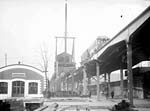 |
n005794.jpg
[off-site link] (93k) |
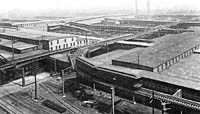 |
SSEwoods@racine-exchange.jpg
(151k) |
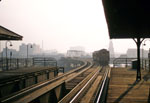 |
exchange02.jpg (149k) A two-car train of ex-Metropolitan "L" wood cars departs Exchange on its way to Indiana station, looking east on September 16, 1957. The Stock Yards branch made a slight jog to the north just east of Exchange station. The bridge in the background crosses one of the many branches of the Chicago Junction Railroad around the Stock Yards complex. (Photo by George Krambles, courtesy of the Krambles-Peterson Archive) |
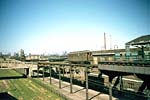
|
cta2906@armour.jpg (140k) |
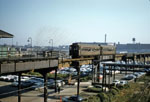 |
cta2918.jpg (193k) Car 2917 makes up half of this two-car train of wooden ex-Met "L" cars near Armour station on the Stock Yards branch on September 30, 1957. The last wood cars operated on the system were ex-Metropolitan Elevated cars; the SY would close a week after this photo was taken and the Kenwood branch followed a few months later. The cars of the 2858-2927 group, built by Pullman for the Met in 1906-07, featured a steel underframe to prevent the wooden car body from sagging; many Met car series had this feature. This steel underframe insured a long life, and were part of the reason these cars lasted to the end of wood-car service. (Photo by George Krambles, courtesy of the Krambles-Peterson Archive) |
 |
CJ_ROW@Federal.jpg
(96k) |
|
|